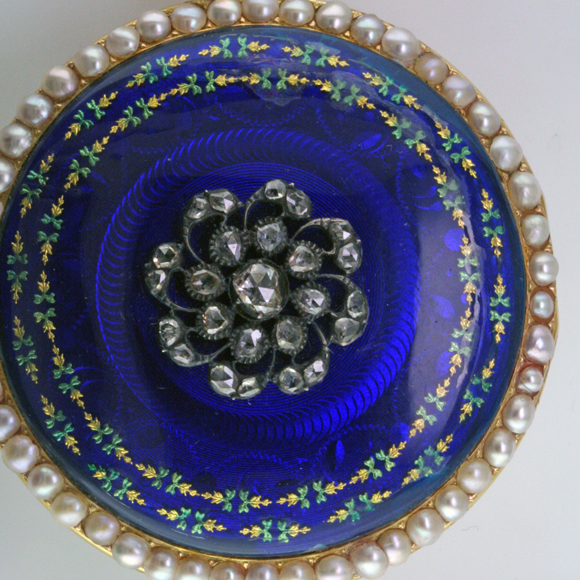We recently had the pleasure of examining this superb antique chatelaine. Centuries ago, the lady of the house wore the chatelaine, a strap or bag looped over a belt at the waist. Typically, the various tools necessary for her to deal with her daily tasks, items such as keys, scissors, watches, etc. were attached with chains. During the last half of the 18th century, the chatelaine became the in fashion among the aristocracy. This particular piece was obviously for the very wealthy– solid 18 karat gold beautifully decorated with rose cut diamonds, exquisite enameling and pearls. It was made circa 1780, just prior to the French Revolution by the watchmaker Robert Robin, a favorite of Marie Antoinette.
The chatelaine shows several enameling techniques. Enameling is an ancient decorative technique in which powdered glass is fused directly on to metal. We don’t know if Robin actually did the enameling on this piece– it’s likely that he had a specialist enamel his work.
The watch dial has an opaque white enamel base to which the delicate numbers, letters and decorations have been painted with an ultra fine powder of black enamel, then delicately fired.
The back of the watch is a tour-de-force example of guilloche enamel, a variant of basse-taille enameling. Guilloche enameling is most famously seen on many of the magnificent Faberge eggs made for the Czar of Russia. The surface of the gold was engraved with a precise pattern by a special geometric lathe known as a rose engine. The pattern creates a truly dazzling effect beneath the vivid cobalt blue transparent enamel.
The center is a dramatic whorl of rose cut diamonds set in silver– the jewelers of the time didn’t yet work with platinum or white gold. The diamond setting was attached via rivets thru special openings in the enamel. The pearls surrounding the enamel were natural Oriental pearls, most likely from the Persian Gulf or the Indian Ocean, set into the gold after the last firing and finishing of the enamel.
Around the edge, we see exquisite bright golden leaves within the enamel. The enamelist made these from hi karat gold foils. As seen by the uniformity of the decorations, he probably used a tiny die and hub like a cookie-cutter to cut the delicate foil. The foils were carefully applied to the enamel surface with special adhesive that would dissipate during the firing process, then covered with subsequent layers of enamel. The enamel was applied in many thin layers, firing the gold disc almost to melting over and over again. A piece like this could easily have a dozen firings.
The chains of the chatelaine feature several different enameled components. This painted enamel panel shows a classic scene. The enamelist used ultra fine opaque enamel powders, ground almost to dust and carefully sieved, then applied like paints. The fineness of the enamel means the firing process is extra critical.
Jewelry enameling is not a lost art. Today’s artisans have the know-how but don’t often have the patronage to invest the hours required to make pieces like this. In subsequent posts, we’ll discuss the basics of enameling in more detail, show other techniques, and show more examples of period and modern enamels. Stop by Mardon to see enameled jewelry par excellence!
james l. sweaney cga fga. gg
Latest posts by james l. sweaney cga fga. gg (see all)
- Hand Engraving– the Ultimate Jewelry Decoration - November 12, 2015
- Benitoite & Platinum Engagement Ring–Strictly Custom - September 4, 2014
- The Creative Process in Us All - August 8, 2014







Post a Comment